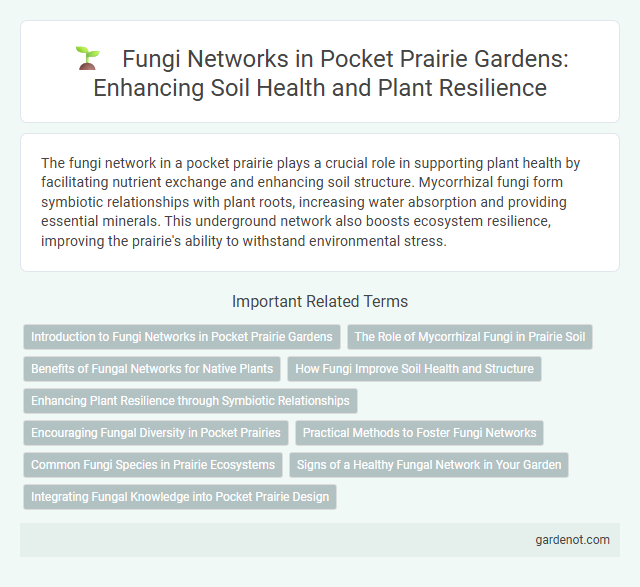The fungi network in a pocket prairie plays a crucial role in supporting plant health by facilitating nutrient exchange and enhancing soil structure. Mycorrhizal fungi form symbiotic relationships with plant roots, increasing water absorption and providing essential minerals. This underground network also boosts ecosystem resilience, improving the prairie's ability to withstand environmental stress.
Introduction to Fungi Networks in Pocket Prairie Gardens
Fungi networks in Pocket Prairie gardens form intricate underground mycelial systems that facilitate nutrient exchange and communication between plants. These symbiotic relationships enhance soil health by decomposing organic matter and promoting plant growth through improved water and nutrient absorption. Understanding fungi networks is essential for optimizing ecosystem resilience and biodiversity in Pocket Prairie settings.
The Role of Mycorrhizal Fungi in Prairie Soil
Mycorrhizal fungi form symbiotic relationships with prairie plants, enhancing nutrient uptake by extending root systems through a vast underground network. This fungal network improves soil structure, increases water retention, and promotes resilience against drought conditions common in prairie environments. By facilitating nutrient exchange and supporting plant health, mycorrhizal fungi are essential for maintaining the biodiversity and ecological stability of pocket prairies.
Benefits of Fungal Networks for Native Plants
Fungal networks, especially mycorrhizal fungi, form symbiotic relationships with native plants, enhancing nutrient absorption and water retention in the soil. These networks increase plant resilience against environmental stressors such as drought and disease by facilitating communication and nutrient exchange between plants. Pocket prairies benefit significantly as fungal networks improve soil health and support diverse native plant communities, promoting ecological stability.
How Fungi Improve Soil Health and Structure
Fungi form intricate mycelial networks in pocket prairies that enhance soil health by breaking down organic matter, releasing essential nutrients like nitrogen and phosphorus into the soil. These networks improve soil structure by binding soil particles together, increasing aeration, water retention, and root penetration. By fostering symbiotic relationships with plant roots through mycorrhizal associations, fungi boost plant nutrient uptake and resilience, promoting a thriving prairie ecosystem.
Enhancing Plant Resilience through Symbiotic Relationships
Fungi networks in pocket prairies form extensive mycorrhizal associations that facilitate nutrient exchange, enhancing plant resilience against drought and pathogens. These symbiotic relationships increase soil health by improving water retention and nutrient uptake efficiency. Leveraging mycorrhizal fungi biodiversity strengthens ecosystem stability and promotes sustainable plant growth in restored prairie habitats.
Encouraging Fungal Diversity in Pocket Prairies
Encouraging fungal diversity in pocket prairies enhances soil health and nutrient cycling by promoting symbiotic relationships with native plants. Mycorrhizal fungi improve water retention and increase plant resilience against pests and environmental stressors. Diverse fungal networks also support decomposition processes, contributing to the overall ecosystem stability and biodiversity within compact urban green spaces.
Practical Methods to Foster Fungi Networks
Integrating diverse organic materials such as compost, mulch, and leaf litter creates a nutrient-rich environment that promotes the growth of beneficial fungi networks in pocket prairies. Inoculating soil with mycorrhizal fungi spores or introducing fungal-rich soil from healthy ecosystems accelerates symbiotic relationships with native plants, enhancing soil structure and nutrient uptake. Maintaining consistent moisture levels through drip irrigation or mulch layers prevents fungal dehydration, supporting robust hyphal connectivity and overall ecosystem resilience.
Common Fungi Species in Prairie Ecosystems
Common fungi species in prairie ecosystems include mycorrhizal fungi like Glomus and Rhizophagus, which form symbiotic relationships with prairie grasses, enhancing nutrient absorption and soil health. Saprophytic fungi such as Penicillium and Aspergillus contribute to organic matter decomposition, recycling nutrients vital for plant growth. These fungal networks improve soil structure, support plant diversity, and play a crucial role in maintaining the resilience of pocket prairie habitats.
Signs of a Healthy Fungal Network in Your Garden
A healthy fungal network in your pocket prairie garden is indicated by the presence of rich, dark soil teeming with organic matter and consistency in moisture levels. Visible signs include abundant mycelium threads weaving through the soil and thriving plant roots forming mycorrhizal associations. Increased plant vigor and resistance to drought stress further reflect a well-established, functional fungal network supporting nutrient cycling and soil structure.
Integrating Fungal Knowledge into Pocket Prairie Design
Integrating fungal knowledge into pocket prairie design enhances soil health and plant resilience by promoting mycorrhizal networks that facilitate nutrient exchange. Understanding species-specific fungal interactions allows for selecting native fungi partnerships that optimize decomposition and nutrient cycling. This symbiotic approach improves ecosystem sustainability and supports diverse plant communities within compact urban landscapes.
Fungi network Infographic

 gardenot.com
gardenot.com